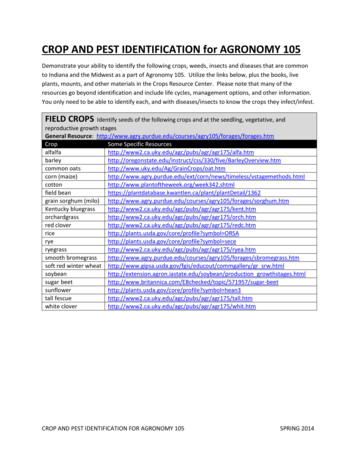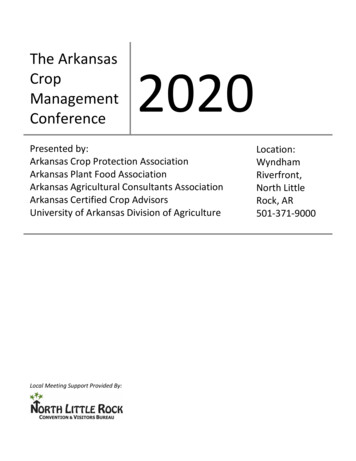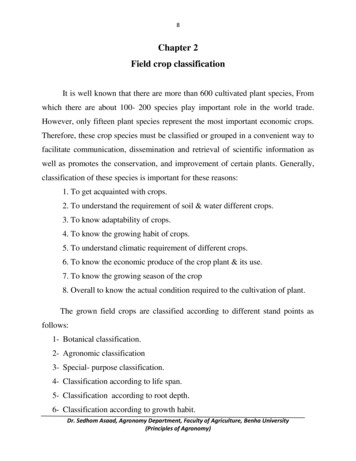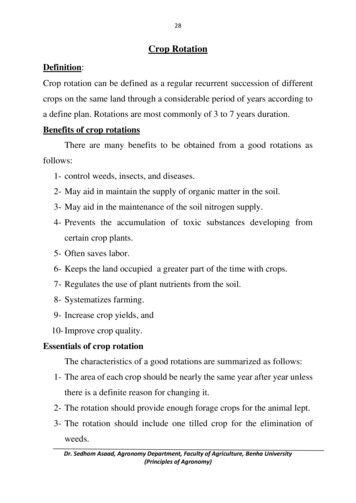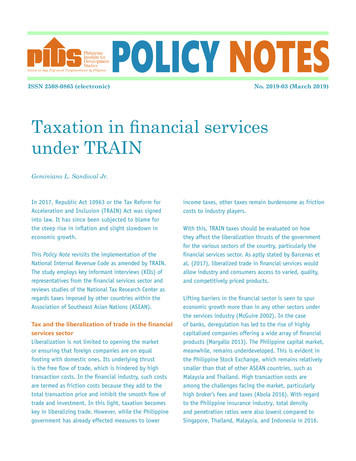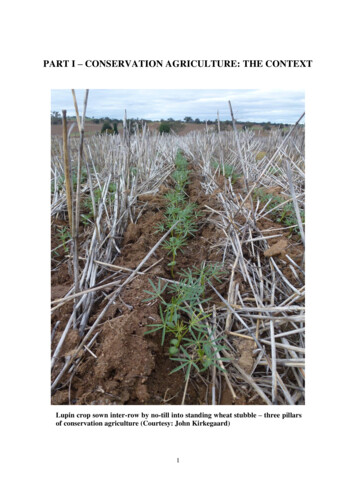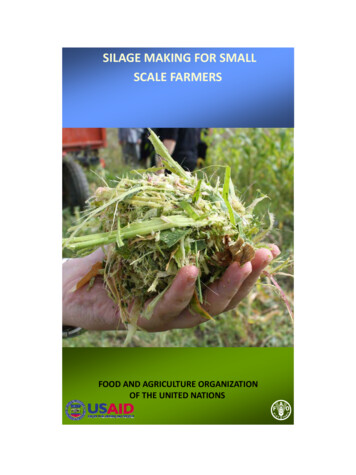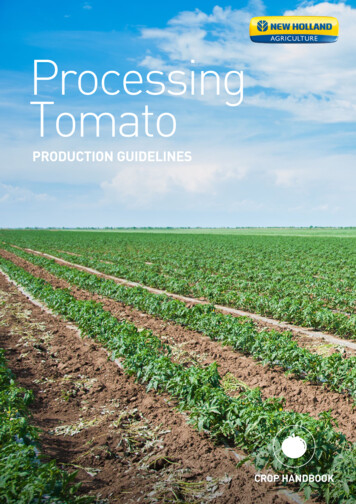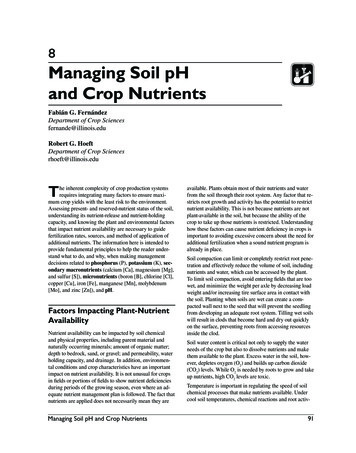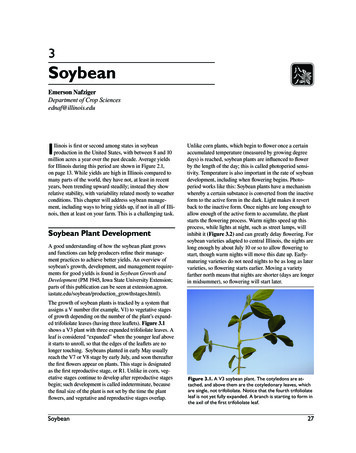
Transcription
3SoybeanEmerson NafzigerDepartment of Crop Sciencesednaf@illinois.eduIllinois is first or second among states in soybeanproduction in the United States, with between 8 and 10million acres a year over the past decade. Average yieldsfor Illinois during this period are shown in Figure 2.1,on page 13. While yields are high in Illinois compared tomany parts of the world, they have not, at least in recentyears, been trending upward steadily; instead they showrelative stability, with variability related mostly to weatherconditions. This chapter will address soybean management, including ways to bring yields up, if not in all of Illinois, then at least on your farm. This is a challenging task.Soybean Plant DevelopmentA good understanding of how the soybean plant growsand functions can help producers refine their management practices to achieve better yields. An overview ofsoybean’s growth, development, and management requirements for good yields is found in Soybean Growth andDevelopment (PM 1945, Iowa State University Extension;parts of this publication can be seen at extension.agron.iastate.edu/soybean/production growthstages.html).The growth of soybean plants is tracked by a system thatassigns a V number (for example, V1) to vegetative stagesof growth depending on the number of the plant’s expanded trifoliolate leaves (having three leaflets). Figure 3.1shows a V3 plant with three expanded trifoliolate leaves. Aleaf is considered “expanded” when the younger leaf aboveit starts to unroll, so that the edges of the leaflets are nolonger touching. Soybeans planted in early May usuallyreach the V7 or V8 stage by early July, and soon thereafterthe first flowers appear on plants. This stage is designatedas the first reproductive stage, or R1. Unlike in corn, vegetative stages continue to develop after reproductive stagesbegin; such development is called indeterminate, becausethe final size of the plant is not set by the time the plantflowers, and vegetative and reproductive stages overlap.SoybeanUnlike corn plants, which begin to flower once a certainaccumulated temperature (measured by growing degreedays) is reached, soybean plants are influenced to flowerby the length of the day; this is called photoperiod sensitivity. Temperature is also important in the rate of soybeandevelopment, including when flowering begins. Photo period works like this: Soybean plants have a mechanismwhereby a certain substance is converted from the inactiveform to the active form in the dark. Light makes it revertback to the inactive form. Once nights are long enough toallow enough of the active form to accumulate, the plantstarts the flowering process. Warm nights speed up thisprocess, while lights at night, such as street lamps, willinhibit it (Figure 3.2) and can greatly delay flowering. Forsoybean varieties adapted to central Illinois, the nights arelong enough by about July 10 or so to allow flowering tostart, though warm nights will move this date up. Earlymaturing varieties do not need nights to be as long as latervarieties, so flowering starts earlier. Moving a varietyfarther north means that nights are shorter (days are longerin midsummer), so flowering will start later.Figure 3.1. A V3 soybean plant. The cotyledons are attached, and above them are the cotyledonary leaves, whichare single, not trifoliolate. Notice that the fourth trifoliolateleaf is not yet fully expanded. A branch is starting to form inthe axil of the first trifoliolate leaf.27
Variety SelectionFigure 3.2. Interruption of flowering led to late maturityof soybean plants that receive the light from street lamps.These plants were frosted before the photo, but pods arestill green.Once flowering starts, we track the development of flowers and then pods and seeds, with stages R3, R5, and R7marking the beginning of pod setting, pod filling, andmaturity, and stages R2, R4, R6, and R8 marking stagesof full flowering, pod setting, seed filling, and maturity.One advantage that soybean has over corn is that theflowering and seed-filling stages take several weeks tocomplete, and if there are stresses such as dry soils during this time, relief of such stresses during these criticalstages can often allow the plant to recover. Early-maturingvarieties develop more quickly, so they have a shorter timeover which such recovery is possible. Pod filling normallystarts in early August and can be nearly finished by earlySeptember.Besides differing from corn in the timing and duration ofyield-making events such as flowering and seed filling,soybean plants also tend to produce considerably more leafarea than corn plants, at least collectively in the field. TheLAI (acres of leaves per acre of crop) is often as high as 6or 7 in soybean compared to 3.5 or 4 in a good corn crop.This is part of the reason that soybeans are less sensitive tolower plant populations compared to corn. But producingso much leaf area also takes a great deal of energy, and tothe extent that some of the leaf area is not normally neededto produce maximum yields, production of a lot of leaf areacan lower plant efficiency. In years with a lot of rainfallin June and July, in fact, leaves are often larger and stemslonger, which can result in shading and less seed filling ofpods lower in the crop canopy. Seeds in a pod are usuallyfilled using sugars from the leaf attached to the same nodeas that pod, so if leaves cannot reach into the light, thepods at the same node may not fill completely.Soybean varieties are divided into groups according totheir relative times of maturity. These maturity groups(MGs) are usually designated using Roman numerals,from 0 (or several zeroes, for very short-season varieties)to MG IX or higher for types developed for very warmclimates with shorter days during the growing season. It isalso common practice to add a decimal to the MG number,and to refer, for example, to a variety as MG 2.4 or 3.6, todenote gradations within a maturity group. MG numbersare assigned by breeders, and many naming systems forcommercial varieties include the MG number (and often adecimal) as part of the name.Varieties of MG I can be grown in northernmost Illinois,but they are too early for good growth and yield farthersouth. Varieties of MG IV are best adapted in southern Illinois, and a few MG V varieties are grown in the southernmost areas. Growing soybeans that effectively use the fullgrowing season is generally beneficial to yield, though wehave seen limited benefits from using very late-maturingvarieties, even if they are able to complete seed fill beforefrost. As is the case with corn, there has been more breeding attention paid to improving varieties in MG I throughMG III than in later-maturing groups. One reason for thisis that the mid-South (Arkansas, Tennessee) now produceearlier-maturing soybeans—often MG III and IV—in orderto escape hot, dry conditions in late summer. This hasdiminished the demand for varieties in MG V and later.Nearly all soybeans grown in the Midwest have an indeterminate growth habit, meaning that vegetative growth continues beyond the time when flowering begins, up to aboutthe time that seed filling begins (R5). Several decadesago, some short-statured determinate or semideterminate(cross of determinate and indeterminate) varieties withmaturities appropriate to Illinois were released. The shortstature helps these varieties resist lodging in high-yieldenvironments. But they also need above-average growingconditions before flowering to consistently offer a yieldadvantage, and stress early in the season can result in veryshort plants and low yields. As a result, few determinatevarieties are grown today.Hundreds of soybean varieties—nearly all privatelydeveloped—are named and sold by seed companies. Mostsoybean acres in Illinois are planted from MG II, III, orIV, with a few MG I and V varieties grown in the northernand southern ends of the state, respectively. For specificperformance data on both public and private varieties,consult the latest issue of Performance of CommercialSoybeans in Illinois, or visit the website at vt.cropsci.illinois.edu/soybean.html.28Illinois Agronomy Handbook
While the several different glyphosate-resistant genes arethe only GM trait now widely available in commercialvarieties, the next few years will see commercial releaseof GM varieties with traits to give resistance to otherherbicides (glufosinate, or Liberty; and dicamba, or Banveland other trade names) and possibly some with diseaseresistance and even “yield” genes, though it’s not clearthat the latter will require gene transfer (or be called GM),since they will likely come from soybean. Other GM traitsof interest in soybean might include Bt for insect resistance and some quality traits. There continues to be someconsumer resistance to GM soybeans regardless of whattrait is involved. This may continue to slow the release ofsome novel GM traits in soybean, especially those varieties developed for use in foods.When choosing a variety, first consider a suitable maturity coupled with a good yield record. Further refine yourselection by considering the variety’s genetic resistance toprevalent pest problems. Another trait to keep in mind isstandability, though this is not as big an issue as with cornor as it was with older soybean varieties. Commercial varieties have also been selected against the tendency to haveseed shatter from pods before harvest, though unusualweather can still cause some of this. If you are producingfor niche-market contracts, your choices will be relativelylimited and may not include the best-yielding or most pestresistant varieties.So far, there have been few releases of varieties bredespecially to have more protein, oil, or other constituentsthan do normal varieties. Such quality traits are important,however, and breeders avoid releasing varieties that arelower than normal in protein and oil. The use of soybeanoil as biodiesel has increased demand for the oil, and theincreased availability of corn protein extracted during ethanol production has meant increased competition with soybean protein for use in animal feed. Improvements in thenutritional and feed quality of protein and oil are certainlypossible. But it remains difficult to breed for large changesin content, if not quality, of these key components.SoybeanPlanting DateBecause of the flowering mechanism described, laterplanting often does not delay flowering as much in soybean as it might in corn; the rule of thumb is that soybeanneed about 6 weeks of warm weather to develop enoughsize for best yields by the time flowering occurs. If it’swarm and soybean plants begin to flower during the firstor second week of July, planting later than late May willnot usually allow enough growth for best yields, unlessconditions are ideal later in the season. For this reason,soybeans generally yield best when planted in May, withfull-season varieties tending to yield best when plantedin early May. Earlier varieties tend to be less sensitiveto planting date, as long as they are planted by late May.When planting of full-season varieties is delayed untillate May, the loss in yield is comparatively less than thepenalty for planting corn late. Planting soybeans after cornhas been planted is thus the best strategy.Figure 3.3 shows planting date responses from severalstudies, one conducted by University of Illinois agronomists in northern Illinois in the early 1990s, the second byPioneer Hi-Bred International agronomists over a rangeof Corn Belt locations in 2001, and the third by Dr. PallePedersen of Iowa State University at several sites in 2004,a year of very high yields. These results show the variability over years and environments in the response ofsoybean to planting date. But planting in the first half ofMay normally produces the best yields. Planting in April,especially early April, can reduce yields, even when standsare good. Planting delays to the end of May often carryrelatively mild penalties, though this varies a great dealamong years. The reason we see such variability is that7060Yield (bu/A)Since their first release in the mid-1990s, Roundup Readysoybean varieties have come to occupy more than 90%of the soybean acreage in Illinois. Most people agree thatsome of the early-released varieties of Roundup Readysoybeans were agronomically inferior, mostly becauseonly limited germplasm was available for release. Thesevarieties have been replaced by newer releases, and todaymost available data indicate that if there is a yield difference between these two groups of varieties, it is probablyin favor of the Roundup Ready varieties. Because these varieties make up such a high percentage of the seed market,private breeding companies have directed most of theirefforts to improvement of these and other GM Apr12-May1-Jun21-Jun11-JulPlanting dateFigure 3.3. Soybean planting date response in three different trials. The PHI results were generated by agronomistswith Pioneer Hi-Bred International using several differentvarieties, the Illinois results are from trials run in northernIllinois, and the Iowa results are from Dr. Palle Pedersen ofIowa State University, from work done in 2004.29
conditions later in the season can add to or greatly diminish potential problems from late planting. For example, the2008 season was relatively cool and wet, and widespreaddelays in planting were followed by very slow developmentand late maturity. Even so, yields ranged from good tovery good, even in fields planted in mid-June or later.If temperatures are close to normal, planting date affectsthe length of time required for soybeans to mature, withdelays resulting in fewer days needed for the plant to complete its life cycle. The period from planting to the beginning of flowering is typically 45 to 60 days for full-seasonvarieties planted at the normal time. This interval is shortened as planting is delayed; it may be only about 25 dayswhen such varieties are planted in late June or early July,but this also means that plants may be small and canopymay be less than adequate when flowering starts. A rule ofthumb is that for each 2- to 3-day delay in planting, plantsreach maturity one day later. The lengths of the floweringand pod-filling periods also are shortened, but the effect oflate planting on these phases of development is minor.Planting dates that extend into June often decrease yieldsubstantially. Such late planting tends to result in a shortersoybean plant with considerably fewer leaves, reducing theyield potential per plant. It is possible to offset somewhatthe changes in plant morphology by planting late-seededsoybeans in narrow rows and at a seeding rate higher thanis used for early planting. Double-crop soybeans, whichare planted after wheat harvest and so are always plantedlate, often benefit from having narrow rows and highseeding rates. Dry soils can significantly delay soybeanemergence and can thus turn it into a “late-planted” cropeven if it was planted on time. It is clear why late-plantedsoybeans are risky and why planting on time is important.Planting Rate and Seed IssuesResearch in Illinois and elsewhere has shown that soybeanyields tend to reach a maximum at populations of about100,000 plants per acre when the crop is planted at thenormal time. In some cases, only 50,000 plants have produced yields as high as plant populations 2 to 4 times thathigh. This illustrates the capacity of an individual soybeanplant to increase its size in response to having more roomin which to grow. Most data also show a very wide “plateau” over which yields respond little if at all to increasingor decreasing population. In rare cases, plant populationcan be high enough to reduce yield, but this seldom occursunless conditions are dry and having more plants causesfaster loss of water.Low soybean plant populations yield less mostly becauseof their inability to form a complete crop canopy and tointercept all of the sunlight they need to produce higheryields. An insufficient plant population will thus limityield to about the extent that plants fail to form a completecanopy of leaves. It is important to soybean yield that thecanopy be more or less complete—that is, that nearly allof the sunlight is being intercepted—by the time podsbegin to form, typically by sometime in the second halfof July. A full canopy of healthy leaves on a well-wateredcrop enables photosynthetic rates to be near their maximum, which helps flowers to stay on the plant and todevelop into productive pods. Thin stands also allow moreweed competition to develop in the crop, and they encourage plants to branch and forms pod closer to the soil line,possibly adding to harvest losses.Figure 3.4 shows seeding-rate responses from a series ofrecent Illinois trials. These trials were done using smallplots, and plant establishment, as a percentage of seedplanted, was high. Variety maturities used were MG II,III, and IV for northern, central, and southern Illinois, respectively. These results show little response from plantingmore than 100,000 seeds in northern and central Illinois,but some response from 100,000 to 150,000 in southern Illinois. These trials were conducted in 30-inch rows; otherresearch has shown no consistent effect of row spacingon plant population responses in soybean when plantingis relatively early. The leveling off at seeding rates above100,000 in most of these trials is consistent with data fromother recent research in Illinois and in other states. Of the16 trials included in the northern and central regions, onlyone showed a yield response above 100,000 seeds per acre,and two showed some yield loss as seeding rate increased.Of the seven southern sites, three produced higher yieldsat 150,000 than at 100,000 seeds.Soybean seed prices have increased a great deal in recentyears, in part due to the fact that most varieties have patented GM traits for which licensing fees are charged. Thussome consideration might be given to applying economicsto seeding rates, with increases or decreases in rates depending on the ratio of seed price to the price of soybeans.Soybean seeds are still sold mostly by weight (in 50-lbunits), but some are beginning to be sold by number, in thesame way that corn seed is sold. If a 50-lb unit of seed has140,000 seeds (2,800 seeds per pound, which is typicalfor soybean seed) and costs 32, and the predicted pricefor soybeans at harvest is 13 per bushel, then calculations using the data in Figure 3.4 show that the seed justpays for itself (that is, is at its economically optimal rate)at a seeding rate of about 90,000 in northern and centralIllinois and about 160,000 in southern Illinois. If thesame seed costs 50 per unit and the soybean price fallsto 8 per bushel, the optimum seeding rates drop to about80,000 in northern and central Illinois and about 130,00030Illinois Agronomy Handbook
80% stand establishment. The main reason for this is thatdrills tend not to place the seed at uniform depth in thesoil and to firm soil around the seed as well as do rowunits. In soils that tend to form a crust, having seeds closertogether in the row—as happens in wider rows—makes itpossible for seeds to exert more force, per foot of row, toemerge through a crust. Seeds in narrow rows, which aretypically planted 5 or 6 inches apart in the row, are too farfrom one another to “help” neighboring plants emerge.Yield (bu/A)605040Northern IL30Central IL20Southern IL100050100150Seeding rate (000/A)200250Figure 3.4. Seeding rate responses in Illinois trials, 2005to 2007. Each region includes data from 7 to 9 trials. Rowswere 30 inches apart. Trials were conducted by Ralph Esgar,University of Illinois.in southern Illinois. While it helps to be aware of the factthat inputs such as seed should be used at rates that takeinto account costs and returns, it is also clear that havingsoybean plant populations too high for the conditions doesnot usually mean lower yield, just some seed cost that didnot provide a return. On the other hand, having seedingrates too low, either purposefully or due to reduced emergence, costs both yield and profit. Thus it is unlikely thata seeding rate of only 80,000 should be used, despite thepossibility that this will be enough in some cases.Seed Quality and TestingOne important issue in choosing seeding rates is estimating how many of the seeds will germinate and emergeand how many of the emerged plants will survive to beproductive. This number is affected by soil type, seedquality, type of planter used, and especially weather conditions after planting; it is not uncommon for good-qualitysoybean seed planted into good soil conditions to fail toproduce adequate stands if heavy rain falls after plantingand before emergence. Failure to produce a soybean standis more common when planting is early, due to coolersoils and increased time to emergence. Planting too deepor just before heavy rain increases the chance of emergence problems due to soil crusting, and it can result inthe death of seeds or seedlings due to lack of soil oxygenand increases in seedling diseases. It may also be useful totry to estimate how emergence might be affected by seedquality and planting conditions. The seed drop calculatorat iah.ipm.illinois.edu/seed drop calculator can help withestimating and with calibrating planters.In the research reported in Figure 3.5, drilling soybeanseed in 7- or 8-inch rows produced stand counts of about70% of the numbers of seeds planted, while planting withrow units in either 15-inch or 30-inch rows produced aboutSoybeanAmong agronomic crops, the seed of soybean is amongthe most difficult to produce and maintain with highquality. Germination percentages can be reduced bypoor weather—especially wetting and drying severaltimes—before harvest. And if the seed dries to below 10%moisture before harvest, even the most careful harvestingand handling can cause mechanical damage that reducesgermination. Because of the potential for problems withquality, soybean seed is cleaned thoroughly to remove anyseeds with unusual shapes, including splits (cotyledonsthat separate when the seedcoat breaks).Soybean seed is tested to determine its emergence potential, and it often undergoes one or more “stress tests” thatattempt to predict emergence under less-than-ideal conditions. The standard warm test, run on absorbent paper inthe laboratory, is required on commercial seed containers;it estimates emergence under ideal conditions of moistureand temperature and of little disease. The “cold test” is themost common stress test; it is designed to see how wellseed will germinate and emerge under cold, wet soil conditions. It includes the use of soil in an attempt to duplicatefield conditions. Cold test scores vary some by laboratory, because soils and soil organisms differ among labs.Because of this, cold test scores need to be used with care;they are most helpful in comparing one lot of seed with9080Yield (bu/A) or %70% re 3.5. Effects of row spacing and planter on soybeanyield and on percentage of seeds that produced plants,averaged over 7 Illinois sites. Data provided by Eric Adee,University of Illinois.31
another tested in the same laboratory. Unlike warm tests,the results of cold tests need not be provided to the seedpurchaser. Cold scores tend to be “worst-case” predictors;they are often considerably lower than warm scores andare usually lower than actual field emergence.Another type of seed stress test is the accelerated agingtest, in which seed is exposed to high temperatures andhumidity before germination is tested. Such conditions arerarely encountered by seed before it is planted, but this testprovides an estimate of seed vigor, which is the extent towhich the seed has maintained intact its ability to germinate and produce a healthy seedling. Vigor is not exactlythe same as germinability; over time, vigor typically startsto decline before germination percentage declines. Ameasure of vigor can thus be helpful in predicting whethergood seed will remain good until it is planted.Seed SizeThe fragility of soybean seed compared to the seed ofmany crops is due to its relatively large size; its growth inside pods with thin walls that do not protect it particularlywell from weather, insects, and diseases; and the ease withwhich it can be mechanically damaged. It is also subject toquality problems if conditions are very warm and humidduring maturation. Fortunately, soybean seed developsits ability to germinate relatively early in the seed-fillingprocess—by the time it reaches half to two-thirds its finalweight—meaning that the inherent quality of soybeanseed does not appear to depend on the final size of theseed. Thus seeds that end up smaller than normal due todry conditions or some other stress during seed fillingare very often as capable of germinating and establishingplants as are larger seeds of the same variety.This means that, especially when seed quality tests showno problem with the smaller seed, the use of small seedrepresents little if any risk. Small seed may even havesome advantages: some small-seeded varieties used inparts of the world have excellent seed quality and storability; small seeds need to take up less water in orderto germinate and so may germinate faster; and smallersoybean cotyledons may be able to move up through thesoil during emergence more easily than larger ones would.In fact, with most soybean seed sold by weight (as 50-lbunits) and with seeding rates recommended by numberand not weight, smaller seed may mean lower seed coststhan larger seed.InoculationSoybean is a member of the legume family of plants,most of which have relatively high protein content in theirseeds and so need to take up a lot of nitrogen. Many ofthese plants have the ability to host bacteria in specialstructures, called nodules, on their roots. The plant formsnodules as a reaction to the infection of the root by thesebacteria. Bacteria live in the nodules and are fed by sugarsmoving down from the leaves. In turn, the bacteria convertthe nitrogen from air into forms usable by the plant. Activenodules have a pink color inside. Plants growing in soilswith a lot of nitrogen from fertilizer usually do not havevery many, or very active, nodules. So carryover N from aprevious crop or N produced from soil organic matter candelay or reduce the fixation of N in nodules. On average,soybean plants take up about half of their N from the soiland the other half from N fixation. Somewhat surprisingly,even though N fixation requires energy from the plant andso would seem to detract from yield potential, using fertilizer to supply the N the crop needs very seldom increasessoybean yield.Scientists many years ago recognized that a legume suchas soybean grown in a field where it did not grow beforewill form effective nodules only if some of the necessary bacteria are provided. Bacteria are formulated intoan inoculant material, which is added to soybean seed orinto the soil near the seed at planting. The type of bacterianeeded to produce nodules persists for some years in thesoil once a nodulated crop is grown. For this reason, it israre to get a response to inoculation if soybeans grew inthe same field previously. Research with some of the newerinoculants, including some that use newer, better strains ofbacteria, has shown no consistent yield increase in fieldswhere soybeans have been grown recently in rotation.If soybean grew in a field more than five years earlier, orif soybean never grew in that field before, then inoculationwith a high-quality inoculum is recommended in Illinois.Failure of soybeans to form nodules will usually reduceyields substantially, unless soils contain unusually largeamounts of N. In cases where soybeans are planted onland with no recent history of soybean—for example, onland coming out of CRP—but inoculation is not done, itmight pay to add N fertilizer, up to 200 or 250 pounds ofN, with more on soils with less organic matter. In somesuch cases, however, no N has been added and soybeanplants still seem to get enough N, either from N releasedfrom organic matter and stored in the soil or from activenodules, presumably from bacteria that persisted for a longtime in the soil. One strategy in such a case is to watch thecrop for signs of N deficiency and of nodule formation andto apply fertilizer N only if deficiency symptoms (lightening of green leaf color) develop and nodules fail to form. Ifneeded, N should be applied before flowering begins. Applying half then and the rest at the beginning of pod fillingmight help assure the supply of N at critical stages.32Illinois Agronomy Handbook
Planting DepthEmergence will be more rapid and stands will be moreuniform if soybeans are planted at uniform depths of 1-1/4to 1-3/4 inches. Deeper planting often results in sloweremergence and poor stands, because soils are often coolerwith increasing depth and because deep planting providesmore time for unfavorable weather events and soil crustingto take place before emergence. Though there have beenfew if any measurements of the effects of uneven emergence on soybean yield, it is clear that uniform emergence,which is often related to uniform planting depth and soilconditions at the seed, is a good goal.Varieties differ some in their ability to emerge when planted deeper than normal, though such differences may beless than they were among older varieties. If the description of a variety mentions an “emergence score,” this scorereflects the ability of the seedling hypocotyl to elongateto allow emergence when planting is deeper than recommended. This is a genetic trait, typically measured insand, which may or may not be related to the vigor of theseed or its ability to emerge through soil crusts or underother poor conditions. So the main use of such scores maybe to provide a warning not to plant too deep with
28 Illinois Agronomy Handbook Once flowering starts, we track the development of flow-ers and then pods and seeds, with stages R3, R5, and R7 marking the beginning of pod setting, pod filling, and maturity, and stages R2, R4, R6, and R8 marking stages of
